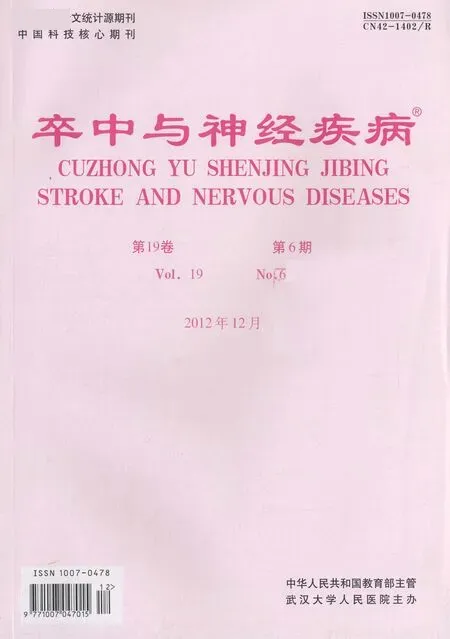房颤患者脑卒中二级预防策略及新型口服抗凝剂的应用
2012-10-18卢祖能
卢祖能
脑卒中是心房颤动(atrial fibrillation,AF)最常见、最严重的并发证。在所有缺血性脑卒中,AF所致者占15%~20%[1]。在18家医院进行的病例对照研究显示,我国AF患者脑卒中的患病率为24.8%[2]。AF使得脑卒中风险增加4~5倍[3]。就缺血性脑卒中严重程度和复发而言,AF为独立危险因素[4]。即使在无症状性AF,脑卒中风险也持续存在[5]。
就AF而言,未来的发病率(即发生AF的危险性)仍然相同,但患病率(即人群中AF的病例数)增加[6],这是因为AF者的寿命在延长。脑卒中患者中随着年龄的逐渐增加,AF所致者的比例将更高。年龄≥70岁的患者中脑卒中主要是AF所致;年龄≥80岁的患者中4个脑卒中1个为AF所致[3];在90岁年龄组中AF所致脑卒中者占所有脑卒中的40%~50%[7]。
1 AF的脑卒中风险:认识不足
为什么应该探测、发现AF?理由主要有二:(1)AF所致脑卒中在很大程度上是可预防的;(2)而且AF所致的脑卒中常常是最严重者之一。
目前,在很大程度上存在对AF问题的认识不足,因为有AF者可没有任何临床症状。仅仅是偶然才发现AF,有时是当患者到了医院才首次发现AF,此时已经患了脑卒中,而这就是我们要预防的[8]。有一种卒中亚型称之为“隐源性脑卒中”,即所谓确切机制未知的脑卒中,尽管进行了各种检查,还是不能找到根本的原因。在23%隐源性TIA或脑卒中患者,通过可移动性心脏遥测装置可发现无症状性AF;大多数(85%)AF发作<30 s[9]。现在值得怀疑的是,这种未发现的阵发性AF占了隐源性脑卒中很大的比例;也就是说,在隐源性TIA或脑卒中患者可能存在未识别的AF。最新的研究也发现,许多隐源性脑卒中可能就是由未诊断的AF所致,因为在安装有起搏器、而无AF临床表现者,亚临床房性快速心律失常(atrial tachyarrhythmias)的发生率很高,且其发作使缺血性脑卒中或系统性栓塞风险显著增加[10]。因此,发现、探测出阵发性AF非常重要,因为这导致脑卒中风险增加。
在AF患者,其另一特征是无症状性脑卒中(silent strokes)的发病率更高——AF为无症状性脑卒中的危险因素。基于人群的研究表明,在2040名无症状者进行MRI检查,大约10%显示至少有1处的静止性脑梗死;AF所致静止性脑梗死常见,是无AF者的2倍左右[11]。
这为什么重要?无症状性脑卒中为临床卒中和血管性痴呆的预测因子。在鹿特丹1077名老年患者基于人群的研究清楚地显示,静止性缺血(MRI探测到梗死/白质病变)的存在,脑卒中风险将增加3倍以上,且与其他危险因素无关[12];如果是75岁以上,未来4年中20%会患卒中。静止性缺血的存在,痴呆风险增加2.3倍,认知功能明显减退[13]。在无症状性脑卒中患者,可引起CT或MRI-T2新的缺血性病灶而无新的临床症状,或者出现与新病灶无关的症状。因此,在无额外危险因素(心血管病共患病、糖尿病等)的老年AF患者,影像学上存在静止性缺血也应考虑为高危患者。
2 AF的抗栓治疗:指南推荐或说明
由于AF患者脑卒中风险明显增高,除非为孤立性AF或存在禁忌证,所有AF患者(包括阵发性、持续性或永久性)均应接受抗栓治疗。根据国内外目前的指南[14~20],常用的抗栓药物有华法林、阿司匹林、氯吡格雷等;另外,关于新型口服抗凝剂(new oral anticoagulant,NOAC),部分指南[18~21]也作了推荐和说明(详后)。
然而,选择何种抗栓药物、如何确定抗栓治疗的强度,与AF患者自身血栓栓塞事件风险的高低密切相关。抗栓治疗主要根据CHADS2(近期充血性心衰、高血压病史、年龄≥75岁、糖尿病病史、脑卒中——最高6分)以及CHA2DS2-VASc[充血性心衰/左室收缩功能受损、高血压、年龄≥75岁、糖尿病、脑卒中/TIA/血栓-栓塞—血管病(既往心肌梗死/周围动脉疾病/主动脉斑块)、年龄65~74岁、性别即女性——最 高 9 分 ]评 分[16~17],通 常 按 危 险 分 层 进 行 处理[15~20](图1)。
脑卒中低危:仅仅有单纯的AF或未证实的危险因素(年龄65~74岁、女性、冠心病或甲状腺毒症)——无需干预或阿司匹林81~325 mg/d。

图1 AF患者脑卒中预防分层策略
脑卒中中危:年龄≥75岁、高血压、心衰、左室收缩功能受损(左室射血分数≤35%)或糖尿病——1个中危因素者,推荐阿司匹林或华法林[目标国际标准化比率(international normalized ratio,INR)2.0~3.0]。
脑卒中高危:既往血栓栓塞 (脑卒中/TIA/全身其他部位栓塞)病史、风湿性二尖瓣狭窄和瓣膜置换术后或1项以上中危因素——华法林(目标INR为2.0~3.0)。
不能口服抗凝剂者,仅推荐阿司匹林[16~17]。置换金属瓣膜的AF患者,应根据瓣膜类型使INR维持在2.5以上。氯吡格雷也可用于预防血栓形成,不需要监测INR、且出血风险低,但其疗效远不如华法林,即使氯吡格雷与阿司匹林合用,其作用也明显差于华法林。不建议阿司匹林与华法林联合应用,因其抗凝作用并不优于单独应用华法林,而出血的危险却明显增加[16~17]。
然而,众所周知,华法林的使用存在一些问题,这也是为什么不如我们想象那样常用[17]。首先,当INR在2.0~3.0范围时,缺血性脑卒中风险显著减低(INR更大,还可减低得更多);但当INR超过3时,颅内出血的风险增加。因此,应根据风险/获益比,小心谨慎地平衡华法林的剂量。
为指导AF患者的抗凝治疗,可参考HAS-BLED(高血压、肝/肾功能异常、脑卒中、出血史或出血倾向、INR不稳定、65以上的年老者、合并使用药物或酒精)评分[22];其分数越高,出血风险越大。
3 新型口服抗凝剂(NOAC):值得期待
华法林的使用,并不如本应该的那样频繁。尽管存在大量证据,而有理由使用华法林的AF患者并未口服抗凝。由于参与华法林代谢的酶CYP2C9和VKORCI存在基因变异,故不同患者对华法林的抗栓治疗反应个体差异非常明显。从未用过华法林者,欲达到稳定的靶目标INR,华法林的用量相差很大。根据“欧洲心脏调查”的结果,在脑卒中低危和高危AF患者,口服抗凝的处方比率并没有什么不同[23]。为什么不能更广泛、更快速使用口服抗凝,可能的原因包括:需要频繁调整剂量;需要有规律性地进行血液监测化验;依从性差;出血风险增加1.7倍;饮食限制;其他禁忌证[15~16]。
目前,我们认识到维生素K拮抗剂(例如华法林)影响内源性途径,可使多个凝血通路(Ⅸ、Ⅶ、Ⅱ)激活或失活。NOAC的特点在于单靶点(Ⅹa因子抑制剂和直接的凝血酶抑制剂),其潜在优势在于其高特异性、良好的疗效-安全性平衡、无需监测或剂量调整(固定的剂量)、快速起效、药物间相互作用少以及与食物无相互作用。
已开发的 NOAC包括达比加群(RE-LY[24~26])、利伐沙班 (ROCKET AF[27~28])以 及 阿 哌 沙 班 (ARISTOTLE[29~30]),可作为华法林(AF患者的标准口服抗凝治疗)的替代。在AF患者,对持续1年以上的随机对照试验的系统回顾和荟萃分析,共44563例患者,比较了上述三大NOAC与华法林的疗效和安全性,结果表明,使用NOAC者——①全因脑卒中和系统性栓塞[相对风险(relative risk,RR)为0.78、95%可信区间0.67~0.92]、缺血性脑卒中和原因未明脑卒中(0.87、0.77~0.99)、出血性脑卒中(0.45、0.31~0.68)、全因死亡(0.88、0.82~0.95)以及血管性死亡(0.87、0.77~0.98)的风险均降低;②颅内出血(0.49、0.36~0.66)的风险较低;③大出血(0.88、0.71~1.09)和胃肠道出血(1.25、0.91~1.72)的风险不确定[31]。总之,在 AF患者,NOAC比华法林预防脑卒中和系统性栓塞更有效[31]。可用于临床的、首批NOAC可用的证据越来越多[19],但大多数抗凝管理问题尚未得到充分研究[20]。尽管如此,新的指南已经对 NOAC的应用作了推荐[18,21]。
目前,在我国已经上市的NOAC仅利伐沙班,但价格昂贵。
4 小 结
AF是脑卒中非常重要的危险因素,特别是老年人;因此,应予以恰当的处理。在隐源性脑卒中患者,可能存在未识别的AF。抗栓药物(抗凝剂)仍为主要治疗,能够明显减低血栓栓塞的发生;目前,在中危~高危AF患者推荐华法林或NOAC,在低危~中危AF患者无需干预或仅推荐阿司匹林(图1)。在目标INR范围,华法林肯定比抗血小板更有效,但很显然又不是那么常规地被应用,这也是为什么没有那么多患者得到治疗的原因。长期用于AF尚需要开发更佳的抗栓药物;根据NOAC几项3期试验的结果,其应用值得期待,但大多数抗凝管理问题尚未得到充分研究。
1 Go AS.The epidemiology of atrial fibrillation in elderly persons:the tip of the iceberg.Am J Geriatr Cardiol,2005,14(2):56-61.
2 胡大一,孙艺红,周自强,等.中国人非瓣膜性心房颤动脑卒中危险因素的病例-对照研究.中华内科杂志,2003,42(3):157-161.
3 Wolf PA,Abbott RD,Kannel WB.Atrial fibrillation as an inde-pendent risk factor for stroke:the Framingham Study.Stroke,1991,22(8):983-988.
4 Penado S,Cano M,Acha O,et al.Atrial fibrillation as a risk factor for stroke recurrence.Am J Med,2003,114(3):206-210.
5 Page RL,Tilsch TW,Connolly SJ,et al.Azimilide Supraventricular Arrhythmia Program (ASAP)Investigators.Asymptomatic or"silent"atrial fibrillation:frequency in untreated patients and patients receiving azimilide.Circulation,2003,107(8):1141-1145.
6 Lakshminarayan K,Solid CA,Collins AJ,et al.Atrial fibrillation and stroke in the general medicare population:a10-year perspective(1992 to 2002).Stroke,2006,37(8):1969-1974.
7 Marini C,De Santis F,Sacco S,et al.Contribution of atrial fibrillation to incidence and outcome of ischemic stroke:results from a population-based study.Stroke,2005,36(6):1115-1119.
8 Khan IA.Atrial fibrillation:interaction between the trigger and the substrate.Int J Cardiol,2003,87(2-3):301-302.
9 Tayal AH,Tian M,Kelly KM,et al.Atrial fibrillation detected by mobile cardiac outpatient telemetry in cryptogenic TIA or stroke.Neurology,2008,71(21):1696-1701.
10 Healey JS,Connolly SJ,Gold MR,et al.Subclinical atrial fibrillation and the risk of stroke.N Engl J Med,2012,366(2):120-129.
11 Das RR,Seshadri S,Beiser AS,et al.Prevalence and correlates of silent cerebral infarcts in the Framingham offspring study.Stroke,2008,39(11):2929-2935.
12 Vermeer SE,Hollander M,van Dijk EJ,et al.Silent brain infarcts and white matter lesions increase stroke risk in the general population:the Rotterdam Scan Study.Stroke,2003,34(5):1126-1129.
13 Vermeer SE,Prins ND,den Heijer T,et al.Silent brain infarcts and the risk of dementia and cognitive decline.N Engl J Med,2003,348(13):1215-1222.
14中华医学会神经病学分会脑血管病学组缺血性脑卒中二级预防指南撰写组.中国缺血性脑卒中和短暂性脑缺血发作二级预防指南2010.中华神经科杂志,2010,43(2):154-160.
15 European Heart Rhythm Association;European Association for Cardio-Thoracic Surgery,Camm AJ,Kirchhof P,Lip GY,et al.Guidelines for the management of atrial fibrillation:the Task Force for the Management of Atrial Fibrillation of the European Society of Cardiology(ESC).Eur Heart J,2010,31(19):2369-2429.
16 Furie KL,Kasner SE,Adams RJ,et al.Guidelines for the prevention of stroke in patients with stroke or transient ischemic attack.A Guideline for Healthcare Professionals from the American Heart Association/American Stroke Association.Stroke,2011,42(1):227-276.
17 Fuster V,Ryd n LE,Cannom DS,et al.2011 ACCF/AHA/HRS focused updates incorporated into the ACC/AHA/ESC 2006 Guidelines for the management of patients with atrial fibrillation:a report of the American College of Cardiology Foundation/American Heart Association Task Force on Practice Guidelines developed in partnership with the European Society of Cardiology and in collaboration with the European Heart Rhythm Association and the Heart Rhythm Society.J Am Coll Cardiol,2011,57(11):e101-198.
18 Skanes AC,Healey JS,Cairns JA,et al;Canadian Cardiovascular Society Atrial Fibrillation Guidelines Committee.Focused 2012 update of the Canadian Cardiovascular Society atrial fibrillation guidelines:recommendations for stroke prevention and rate/rhythm control.Can J Cardiol,2012,28(2):125-136.
19 Ageno W,Gallus AS,Wittkowsky A,et al.Oral anticoagulant therapy:Antithrombotic Therapy and Prevention of Thrombosis,9th ed:American College of Chest Physicians Evidence-Based Clinical Practice Guidelines.Chest,2012,141(2 Suppl):e44S-88S.
20 Holbrook A,Schulman S,Witt DM,et al.Evidence-based management of anticoagulant therapy:Antithrombotic Therapy and Prevention of Thrombosis,9th ed:American College of Chest Physicians Evidence-Based Clinical Practice Guidelines.Chest,2012,141(2 Suppl):e152S-184S.
21 Wann LS,Curtis AB,Ellenbogen KA,et al.2011 ACCF/AHA/HRS focused update on the management of patients with atrial fibrillation(update on Dabigatran):a report of the American College of Cardiology Foundation/American Heart Association Task Force on practice guidelines.Circulation,2011,123(10):1144-1150.
22 Pisters R,Lane DA,Nieuwlaat R,et al.A novel user-friendly score(HAS-BLED)to assess 1-year risk of major bleeding in patients with atrial fibrillation:the Euro Heart Survey.Chest,2010,138(5):1093-1100.
23 Nieuwlaat R,Capucci A,Lip GY,et al.Antithrombotic treatment in real-life atrial fibrillation patients:a report from the Euro Heart Survey on Atrial Fibrillation.Eur Heart J,2006,27(24):3018-3026.
24 Connolly SJ,Ezekowitz MD,Yusuf S,et al.Dabigatran versus warfarin in patients with atrial fibrillation.N Engl J Med,2009,361(12):1139-1151.
25 Diener HC,Connolly SJ,Ezekowitz MD,et al.Dabigatran compared with warfarin in patients with atrial fibrillation and previous transient ischaemic attack or stroke:a subgroup analysis of the RE-LY trial.Lancet Neurol,2010,9(12):1157-1163.
26 Wallentin L,Yusuf S,Ezekowitz MD,et al.Efficacy and safety of dabigatran compared with warfarin at different levels of international normalised ratio control for stroke prevention in atrial fibrillation:an analysis of the RE-LY trial.Lancet,2010,376(9745):975-983.
27 Patel MR,Mahaffey KW,Garg J,et al;ROCKET AF Investigators.Rivaroxaban versus warfarin in nonvalvular atrial fibrillation.N Engl J Med,2011,365(10):883-891.
28 Hankey GJ,Patel MR,Stevens SR,et al.Rivaroxaban compared with warfarin in patients with atrial fibrillation and previous stroke or transient ischaemic attack:a subgroup analysis of ROCKET AF.Lancet Neurol,2012,11(4):315-322.
29 Granger CB,Alexander JH,McMurray JJ,et al.ARISTOTLE Committees and Investigators.Apixaban versus warfarin in patients with atrial fibrillation.N Engl J Med,2011,365(11):981-992.
30 Easton JD,Lopes RD,Bahit MC,et al;ARISTOTLE Committees and Investigators.Apixaban compared with warfarin in patients with atrial fibrillation and previous stroke or transient ischaemic attack:a subgroup analysis of the ARISTOTLE trial.Lancet Neurol,2012,11(6):503-511.
31 Miller CS,Grandi SM,Shimony A,et al.Meta-analysis of efficacy and safety of new oral anticoagulants(dabigatran,rivaroxaban,apixaban)versus warfarin in patients with atrial fibrillation.Am J Cardiol,2012,110(3):453-460.
